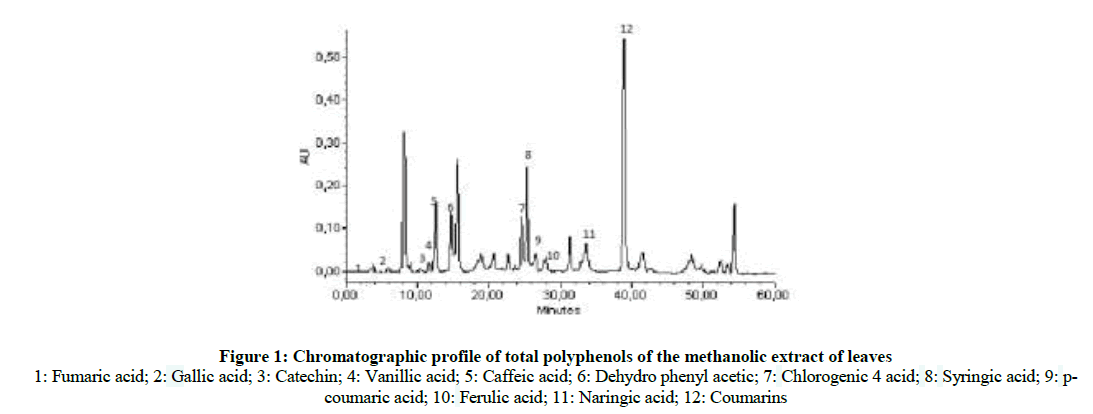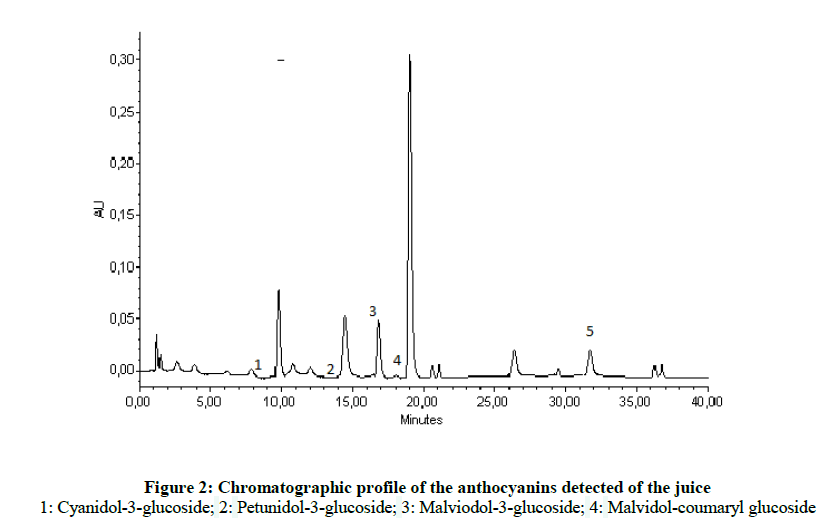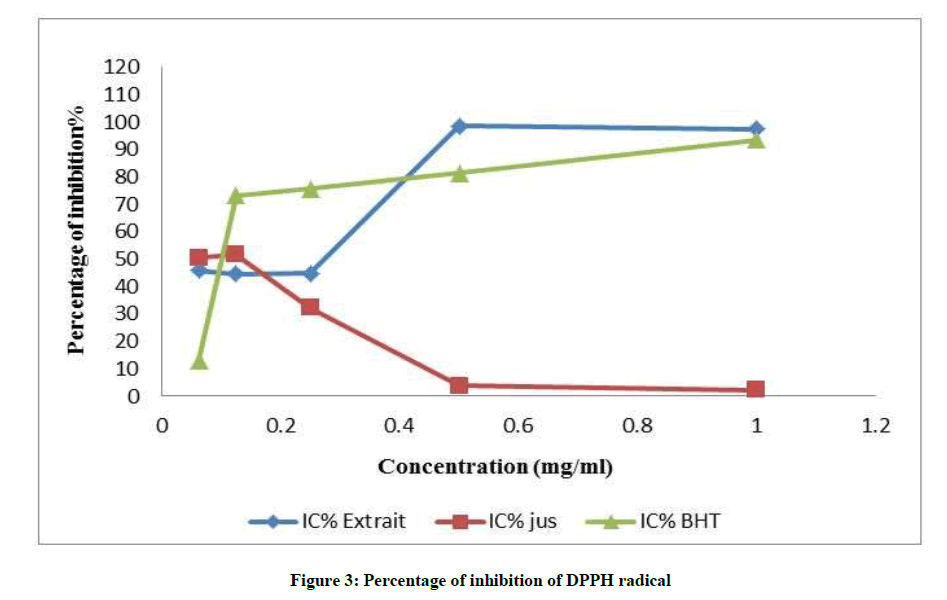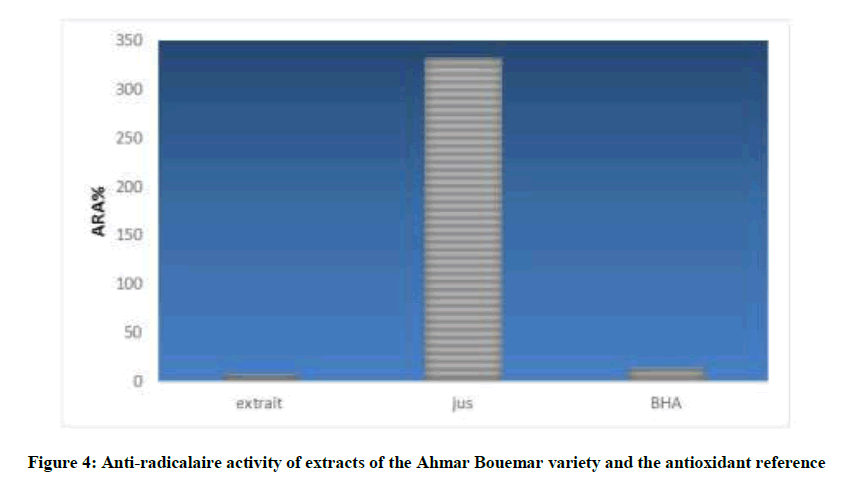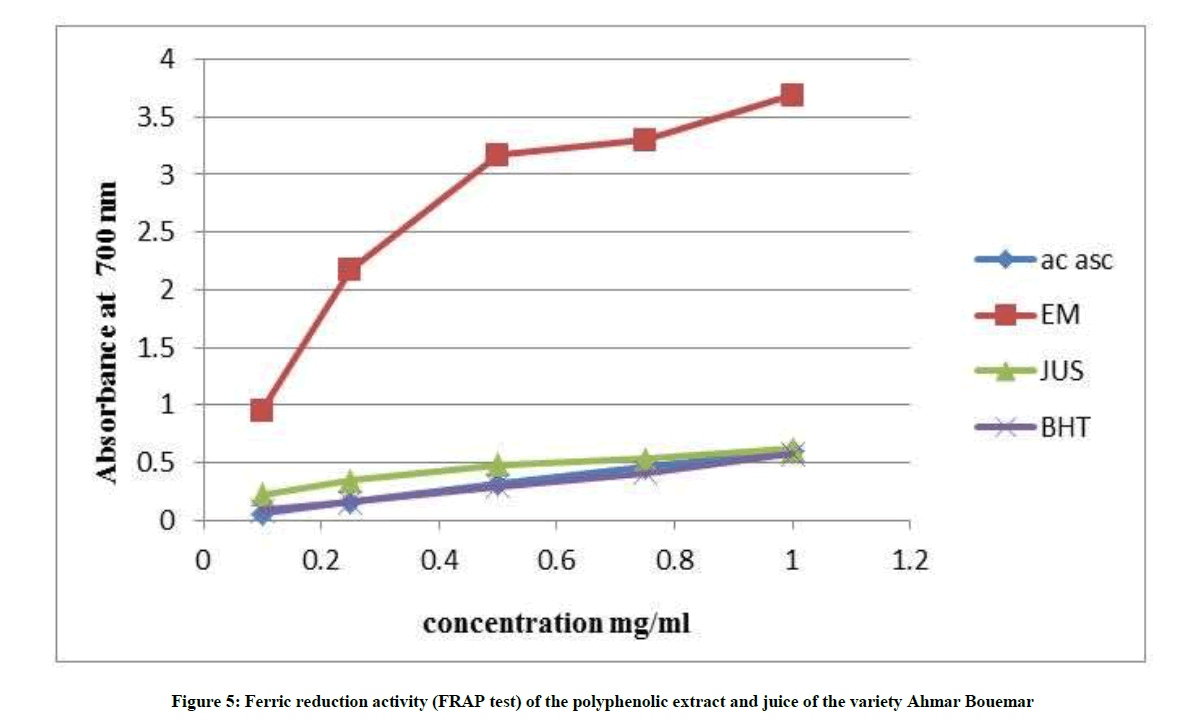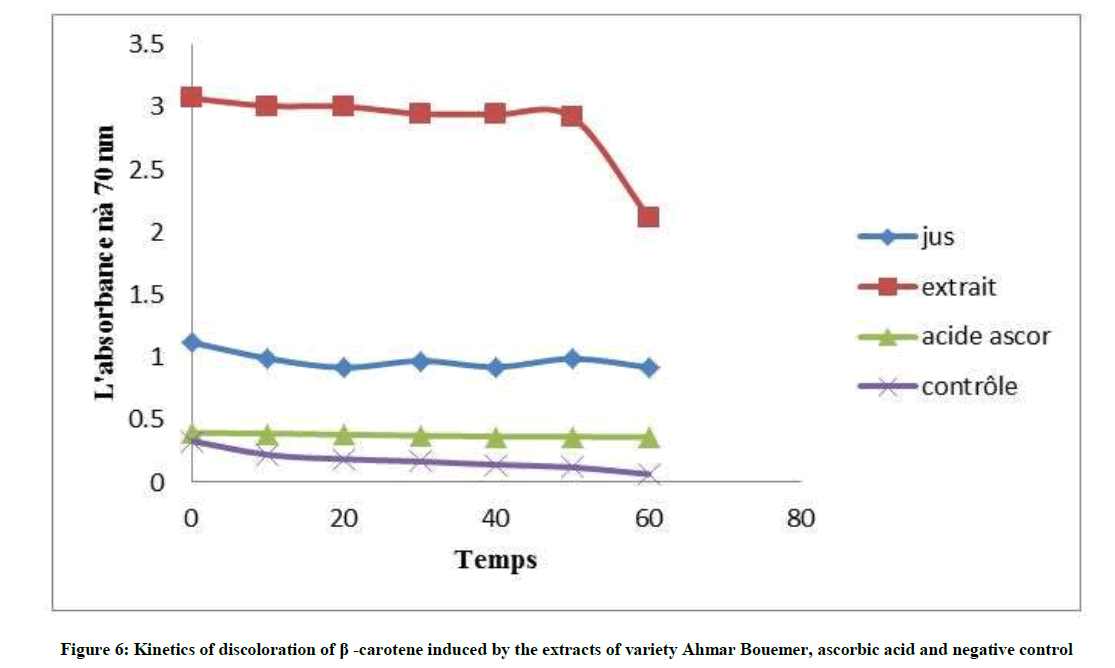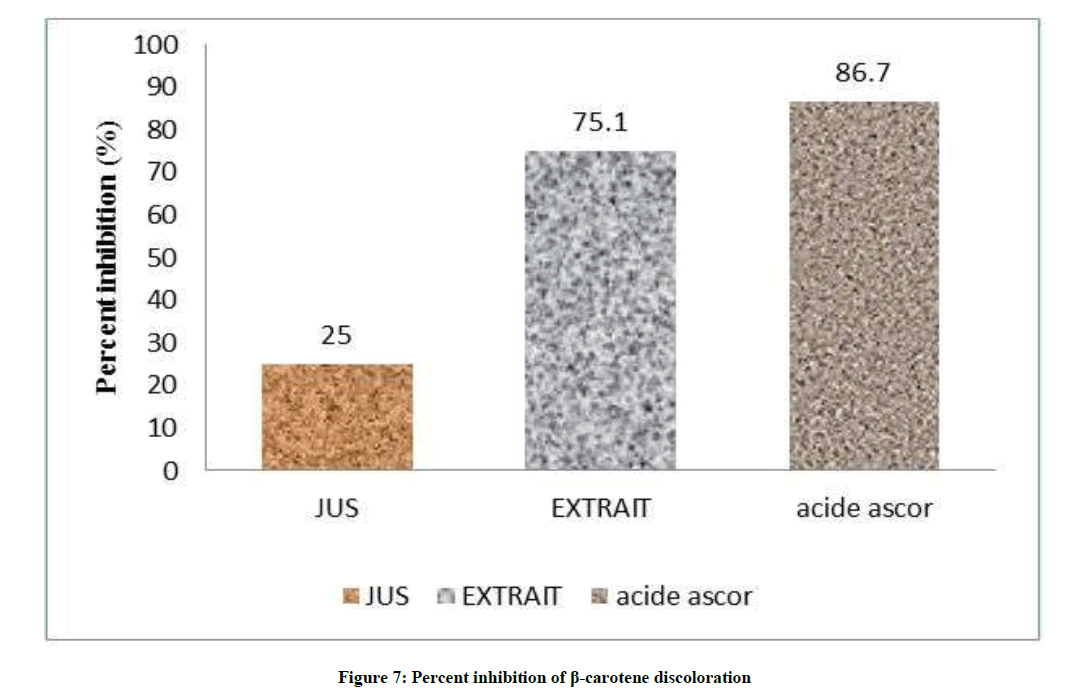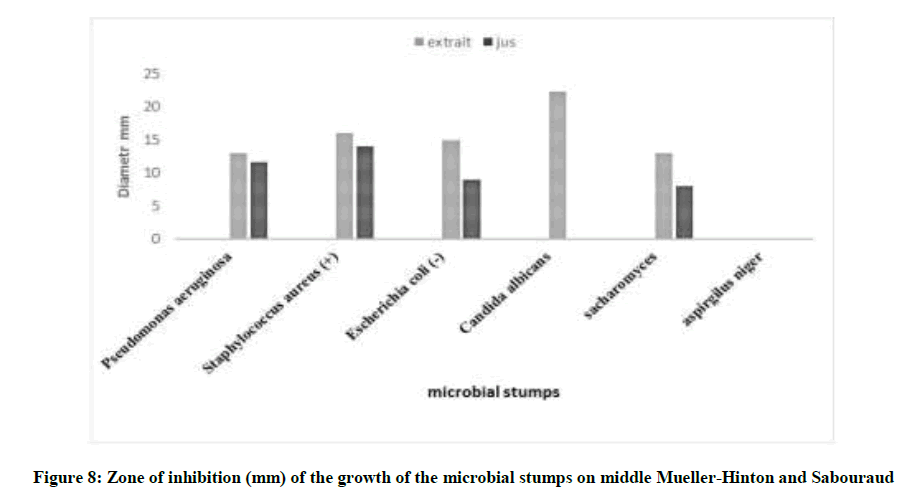Research Article - Der Pharma Chemica ( 2018) Volume 10, Issue 3
Phytochemical Study and Evaluation of the Antioxidant and Antimicrobial Activities of Extracts of the Red Vine
Agouazi Ounissa1,2*, Bouchenak Ouahiba2, Yahiaoui Karima2, Ziriri Djamel3, Khan Feriel3 and Arab Karim2
1Laboratory of Natural Resources, Viticulture/Arboriculture, Faculty of Biological Sciences and Agronomic Sciences, University of Mouloud Mammeri, Tizi-Ouzou, Algeria
2Department of Biology, Laboratory of Valorization and Conservation of Biological Resources, Faculty of Sciences, University of Boumerdes, Algeria
3Sonatrach Research and of Development, Department of Environment, Boumerdes, Algeria
- *Corresponding Author:
- Agouazi Ounissa
Laboratory of Natural Resources
Viticulture/Arboriculture
Faculty of Biological Sciences and Agronomic Sciences
University of Mouloud Mammeri
Tizi-Ouzou, Algeria
Abstract
The phenolic compound presents in a wide variety of fruits and vegetables have antioxidant and anti-radical activities. The European Medicines Agency recognizes that extracts of leaves, seeds or fruits from red vines are endowed with anti-inflammatory, anti-edematous, diuretic and liver protective properties. The purpose of this study is to demonstrate experimentally the antioxidant and antimicrobial effect of leaves and fruits extracts of a local Algerian vine Ahmar Bouemar, of the region of Benchecao (Medea), to value even more its use traditional. The extraction of polyphenols is made from leaves by maceration in a mixture methanol/water (80:20 v/v). For the fruit, we accomplished test on the juice. Extracts were characterized by High Performance Liquid Chromatography (HPLC). The antioxidant capacity of extract was represented using three methods: the test 2,2-Diphenylpicrylhydrzyl (DPPH). Β-carotene and the frappe (Iron reduction). The antimicrobial effect is tested on six microbial strains responsible for some infectious diseases by diffusion method on the agar medium. The yield of polyphenols got is in the order of 33.13%. Majority compounds are coumarins (24.312%), gallic acid (13.31%) and syringic acid (10.19%). The evaluation of antimicrobial activity of these extracts was very significant. The interpretation of results got by this job brings to light that the studied grape variety has remarkable biological properties besides its organoleptic sought-after qualities who serve in search of the best typicalness of grape varieties minor and who can possibly be promoted to the detriment of recent introduction foreign grape varieties.
Keywords
Vitis vinifera L., Local grape variety, Polyphenols, HPLC, Antioxidant activity, Antimicrobial activity
Introduction
Plants are always an essential source of medicaments. Indeed, a majority world population, more particularly in countries in process of development, treats itself mainly with traditional cures based on plants. It is therefore essential to evaluate the biological properties of plants rarely used in traditional medicine.
In the region of study, ethnobotanical study brought to light a particular use of the leaves of the red grapevine only as sedative analgesic. In Algeria, studies that value the integration of vine extracts in the pharmaceutical industries are very rare. The works carried out relates more to the antimicrobial activity of the flavonoid and tannic extracts of the leaves of the wild vine [1] and the antiradical activity of different extracts of red grapevine seeds [2]. For this, we were interested in promoting Algerian endemic grape varieties ""Ahmer Bouemar", in characterizing its secondary metabolites and evaluating these antioxidant and antimicrobial effects.
Material and Methods
Preparation of plant material
Leaves and grapes bunches of the variety AHMAR BOUAMER, local red grape variety (Algerian) were harvested at the end of October in Benchecao region in Medea hills (80 km South of Algiers). Once harvested, leaves are dried has the shelter of light during 15 days then crushed and sieved to recover the drug which will serve for the different analyses. Berries are cleaned of their seeds and manually macerated to recover the juice.
Microbial strains tested
The microbial strains used in this study are provided by the Valcor research laboratory. They are widely encountered in various human pathologies (Table 1).
| Microbial strains | Code | |
|---|---|---|
| Bacteria (Gram-negative) | Escherichia coli Pseudomonas aeruginosa |
ATCC 25922 ATCC 27853 |
| Bacteria (Gram-positive) | Staphylococcus aureus | ATCC 25922 |
| Yeast | Candida albicans | ATCC 26013 |
| Saccharomyces cerevisiae | ATCC 23458 | |
| Mildew | Aspergillus niger | Isolé du pain |
Table 1: Microbial strains tested
Phytochemical screening
The phytochemical tests are accomplished according to the method described by [3]. The sought-after metabolites are anthocyanin’s, tannins, quinones, flavonoids, alkaloids, saponosids, glycosides and coumarins. The method is based on the appearance of a characteristic color or the formation of precipitate after the addition of the specific reactive. The tests are performed both on the plant powder or infused (5%) and on the juice of berries.
Preparation of the extracts
Phenolic compounds of leaves are got by using the method described by [4]. For it, 30 g some plant powder are macerated with 100 ml of a mixture methanol-distilled water (80/20), during 3 days. After filtering, methanolic solution is evaporated broke under pressure reduced in a rotary evaporator of type BUCHI R-210 in 60°C. The weighed dry residue is taken back by 3 ml of methanol and kept in -4°C upto use. For berries, used extract is the raw juice.
Quantification of the total phenolic compounds (PPT) by the method Folin-Ciocalteu
Quantification of the total phenolic compounds is made according to the method described by [5]. It consists in introducing a volume of 200 μl of every extract into test tubes, having figured up to a mixture composed of 1 ml of Folin-Ciocalteu 10 times diluted and 0.8 ml of washing soda in 7.5%. Tubes are agitated and kept for 30 min. The absorbance is measured in 765 nm. A calibration curve with different concentrations of gallic acid was prepared. The contents of total phenols in extracts are expressed in equivalent milligrams (mg) of gallic acid by gram (g) of dry material (mg EAG/g).
Characterization of extracts by High Performance Liquid Chromatography (HPLC)
The chromatographic separation of phenolic compound was performed with a column Ascentis C18 HPLC (250 mm × 4,6 mm, 5 ml, 5 μ), heated to 40°C. The first mobile phase (A) used for separation is composed of water, methanol, acetic acid with proportions 89/10/1 (v/v/v). The second mobile phase (B) is composed of water, methanol and acetic acid with proportions 9/90/1 (v/v/v). In gradient mode, detection was archived at 254 nm. The detector UV-Visible is type TOILETS 2996 (PDA). The volume of injected extract is 20 μl. Analyses were three times repeated.
Antioxidant activity
Scavenging of the free radical DPPH test
The used method is the one described by [6]. So, a solution of 2,2-diphinil-1-picrylhydrazil (DPPH) was prepared by solubilization of 2.4 mg of DPPH (Sigma Chemical Co., the United States) in 100 ml of methanol, 25 μl of various concentration of solutions samples (Extract) and witness (Ascorbic acid) are added in 975 μl of the solution of DPPH. After 30 min of incubation in darkness, the absorbance is measured at 517 nm. The positive control is represented by a standard solution of an antioxidant (Ascorbic acid), whose absorbance is measured under the same conditions as the samples. The test is repeated three times for each concentration. The results are expressed as percent inhibition (I%) according to the following formula:

The IC50 values are determined graphically by linear regression.
Reduction of iron Fluorescence Recovery after Photobleaching (FRAP) test
The reduction of iron is determined with the technique of [7], using ascorbic acid as a standard. The test consists in mixing 1 ml of each concentration of the previously prepared extract, with 2.5 ml of phosphate buffer solution (0.2 M, pH 6.6) and 2.5 ml of potassium ferricyanide [K3Fe(CN)6] (1%). The whole is incubated at 50°C. for 20 min. Then, 2.5 ml of trichloroacetic acid (10%) are added to the mixture. After centrifugation at 3000 rpm for 10 min, 2.5 ml of the supernatant is mixed with 2.5 ml of distilled water and 0.5 ml of FeCl3.6H2O (0.1%). The absorbance of the reaction medium is read at 700 nm. The positive control is represented by the Butylated Hydroxytoluene (BHT) whose absorbance has been measured under the same conditions. The increase in the absorbance in the reaction medium indicates the increase in the reduction of iron.
The ß-carotene bleaching assay
To study antioxidant activity by discoloration method of β-carotene, we adopted the experimental protocol described by [8] in [9]. The emulsion of the antioxidant is prepared by dissolving 2 mg of β-carotene (Fluka, Germany) in 10 ml of chloroform, then 1 ml of this solution is mixed with 20 mg of linoleic acid (Sigma Chemical Co., US) and 200 mg of Tween 40. The chloroform is removed by evaporation and the residue is obtained in 50 ml of hydrogen peroxide. A volume of 200 μl of crude methanol extract or reference antioxidant (Ascorbic acid) at the concentration of 2.5 mg/ml is added to 5 ml of emulsion. A negative control is prepared with 5 ml of the β-carotene emulsion and 200 μl of methanol. The tubes are placed in a Mary bath (Memmert WNB 10) at 50°C and the absorbance reading is made every 10 min for 60 min at 470 nm. Got results are expressed in percentage of inhibition of discoloration of β-carotene by using following expression:
% of inhibition = [1-(In°–At/In°−A°t)] × 100
Where, A°: Absorbance of the sample in t0, At: Absorbance of the sample after incubation of 60 min, A°: Absorbance of negative control in t0, A°t: Absorbance of negative control after incubation of 60 min.
Antimicrobial activity
The technique used to evaluate the antimicrobial activity of the total polyphenol extract is the antibiogram. It is a diffusion method in an agar medium standardized by National Committee for Clinical Laboratory Standards (NCCLS) cited by [10]. A quantity of 1 ml of bacterial or fungal suspensions is spread on MH or BSA medium respectively. Using a sterile forceps, an absorbent disc 6 mm in diameter soaked with 10 μl of the polyphenol extract is deposited on the agar medium (Agar medium) previously inoculated with the microbial strains. The dishes are incubated at 37°C for bacteria and at 25°C for yeasts and molds. The reading is performed after 24 h for bacteria and 48 h for other germs.
Results and Discussion
Chemical screening
The results of the preliminary valuation of the phytochemical composition of leaves and grapes juice of the variety Ahmar Bouamer are represented in the Table 2.
| Metabolites | Juice | Infused (5%) | Metabolites | Juice | Infused (5%) |
|---|---|---|---|---|---|
| Tannins | ++ | +++ | Mucilage | +++ | +++ |
| Leuco-anthocyanins | ++ | +++ | Saponosids | +++ | +++ |
| Anthocyanins | ++ | +++ | Carotenoids | + | ++ |
| starch | - | - | Gallic tannins | - | + |
| Glycosides | + | + | Proteins | ++ | + |
| Reducing Sugars | +++ | + | Flavonoids | ++ | +++ |
| Steroids | - | - | Quinones | - | - |
| Alkaloids | - | - | Lipids | - | - |
| Iridoids | - | - |
Table 2: Results of phytochemical screening
From the results obtained, the studied plant contains polyphenols, represented mainly by flavonoids, tannins, anthocyanins, steroids and saponins. However, it appears that leaves are richer in these secondary metabolites. The juice distinguishes itself by its wealth in primary metabolites (Proteins and reducing sugars). The wealth in secondary metabolites was signaled by [11] for the berries of V. vinifera. This unequal distribution of the total polyphenols between the organs of the same plant has been reported by several authors [12]. She is linked according to [13] to the needs of the plant, point of view reproduction and protection.
Yield of extraction
The yield of methanolic extract obtained from leaves is 33.13% [1] obtained a yield of 16.76% in a study carried out in El Mefteh (Blida) on the wild grapevine (V. vinifera sylvestris). The contents of total polyphenols recorded are in the order of 334.18 ± 2.306 mg EAG/g MS for leaves and in the order of 98.9 ± 323 mg EAG/g MS for the juice. These values gave in agreement with those given by [14] who brought back a rate in PPT of 982.0 ± 58.97 mg/kg of fresh weights in grapes juices of red grapes of Vitis labrusca [15] found respective contents of 184.1 and 213.3 mg/100 g of the fresh weight of white and black grapes (V. vinifera). He comes out again from this comparison that the red grape varieties are richer in secondary metabolites. The wealth of the red grape varieties such as Merlot, Cabernet Sauvignon and Syrah in complete polyphenols is signaled by [16]. This observation is in perfect agreement with the result got for the grape variety Ahmar Bouamer. The content of PPT can be affected according to [8] by the method of extraction, conditions of development and of growth, genotype, maturity and stocking conditions.
Results of the HPLC
The results of the chromatographic analysis of the methanolic extract of the leaves are represented on the following Figures 1 and 2.
Figure 1: Chromatographic profile of total polyphenols of the methanolic extract of leaves
1: Fumaric acid; 2: Gallic acid; 3: Catechin; 4: Vanillic acid; 5: Caffeic acid; 6: Dehydro phenyl acetic; 7: Chlorogenic 4 acid; 8: Syringic acid; 9: pcoumaric acid; 10: Ferulic acid; 11: Naringic acid; 12: Coumarins
The HPLC of extract méthanolique leaves brought to light 24 peaks, among which 12 were identified. The major compounds are coumarins (24.31%), gallic acid (13.31%) and syringic acid (10.19%). Ferric acid, fumaric acid, catechins, vanillic acid, caffeic acid, dehydro phenyl acetic acid, chlorogenic acid, syringic acid and p-coumaric acid are weakly represented. The anthocyanins characterization of juice at 518 nm, demonstrated 18 peaks, of which 5 were identified: Malvidol-3-glucoside (52.24%), cyanidol-3-glucoside (12.12%) and malvidol-peonidol-3- glucoside petunidol-3-glucoside (10.61%, 9.87).
A study by [17] identified chlorogenic acid, caffeic acid and ferulic acid in the red vine (Syrah and Merlot) of the Bekaa region of Lebanon. [18]. Described Malvidol-3- glucoside as the majority anthocyanin in the Big Black and Muscatel with 72.73%.
Antioxidant activity
Trapping of the free radical DPPH
In view of the Figure 3 below, we note that polyphenolic extract of leaves induced an trapping activity of the free radical DPPH more important than that of juices, with respectively a percentage d’ inhibition in the order of 98.5% against 51.59%. These results are similar to obtained by [17] for red grape varieties Cabernet and Sauvignon in the Bekaa region in Lebanon and Syrah. These authors signaled a percentage of trapping of the upper free radical to 70%.
The values of IC50 found for the extract of the leaves and the juice of variety Ahmar Bouemer are respectively 0.14 mg/ml and 0.03 mg/ml. That of the BHT used like standard is of 0.077 mg/ml. Of its results, it arises that the juice presents a better antioxidant activity compared to the extract of the sheets and even with that of antioxidant of reference. The highest antiradical activity is recorded with the juice at a rate of 333.33% (Figure 4).
According to [19], the biological activity of the vegetable material is significantly related to the content of total polyphenols. What explains the results obtained with our extracts.
The ferric reduction (FRAP) test
It can be seen from the Figure 5 that the leaf extract has a strong ability to reduce iron relative to that of the juice, reflected by the optical densities obtained at different concentrations (Maximum OD=3.68 at 1 mg/ml). This absorbance is greater than that expressed by the reference antioxidants such as ascorbic acid and BHT (OD=0.603, OD=0.573) respectively for the same concentration of 1 mg/ml.
The ß-carotene bleaching assay
The rate of discoloration of β-carotene reflects the antioxidant capacity of our extracts. The kinetics of whitening of β-carotene by the extracts of variety Ahmar Bouemar and ascorbic acid recorded after 1 hour is represented in the Figure 6.
The results shows that juice and leaf extract have a strong protective effect against β-carotene discoloration compared to the reference antioxidant (Ascorbic acid). The following Figure 7 shows the percent inhibition of β-carotene discoloration by juice, leaf extract and standards at the same concentration.
It appears that the leaf extract (75.1%) further inhibits the discoloration of β-carotene than the juice (25%). The inhibition capacity is as follows: Ascorbic acid > extracted from leaves > grape juice.
Antimicrobial activity
The antimicrobial test demonstrated an inhibitory effect on the growth of the sprouts, depending on the nature of the strain tested (Figure 8).
The action of phenolic compounds of the extract of the leaves of variety Ahmar Bouemar seems to have an inhibitive effect on the majority of the studied stumps. The diameter of the inhibition zone varied of 13 ± 0.12 mm to 22.33 ± 2.05 mm. In addition, the bacterial strain most sensitive at the juice phenolic compounds is staphylococcus (14 ± 0.45 mm). However, no effect was expressed on yeast and mildew [1], announced that the flavonoidic extract of the wild vine (V. vinifera sylvestris) did not have any inhibiting action on Candida albicans. Another study conducted by [20] on the methanolic extracts of the leaves of V. vinifera L. harvested in Tlemcen, Aflou and Sidi Bel Abbes, revealed a sensitivity of the tested germs in particular E. coli, Proteus mirabilis and Bacillus cereus. These authors did not observe any effect of the extract on Candida albicans and Aspergillus basilicas. This difference is due to the richness of the extracts in phenolic compounds with antibacterial activity. In our study, the extracts used are rich in fumaric acid, gallic acid, catechins, vanillic acid, caffeic acid, chlorogenic acid, syringic acid, p-coumaric acid, ferulic and naringin acid.
Conclusion
The Algerian variety "Ahmar Bouemar" by showing antioxidant and antimicrobial capacities makes it very useful to reinforce the body in case of oxidative stress situation and to remedy the various pathologies related to radical attack. It is therefore imperative to promote this (local) variety as an indigenous variety.
Acknowledgements
Thanks go to the Sonatrach Research and Development Center in Boumerdes for taking part in the realization of this work. The authors also thank the farmer "Ogrid Rachid" from Benchicao (Medea, Algeria) for the supply of plant material.
References
- Naçira Amara, Fatma Zohra Melouk, Algerian J. Nat. Prod., 2016, 4(3), 358-366.
- Z. Ghouila, S. Laurent, C. Henoumont, L. Vanderelst, N.R. Muller, A. Baaliouamer, J. Fundam. Appl. Sci., 2016, 8(3), 692-711.
- B.S. Wong, M.C. Hsu, C.C. Wu, C.W. Hsieh, Pharmacol. Res., 2005, 53 113-122.
- E. Revilla, E. Garcia-Beneytez, F. Cabello, G. Martin-Ortega, J.M. Ryan, J. Chromatogr. A., 2001, 915, 53-60.
- S. Hogan, L. Zhang, J. Li, B. Zoecklein, K. Zhou, Food Sci. Technol., 2009, 42, 1269-1274.
- Bozin M. Oyaizu, Jpm. J. Nutr., 1986, 44, 307-315.
- T. Sun, J.R. Powers, J. Tang, Food Chem., 2007, 105, 101-106.
- L. Zhu, Y. Zhang, J. Lu, Int. J. Mol. Sci., 2012, 13, 3492-3510.
- M.R. Moreira, A.G. Ponce, C.E. Delvalle, S.I. Roura, Global Research Database., 2005, 565-570.
- C.D. Kappel, Integrative biology of the grape berry metabolism, Ph.D. thesis. Vector University Segalen Bordeaux, 2010, 177.
- C. Maugé, Biosynthesis of Flavan-3-ols in Vitis vinifera: structure, catalytic mechanism and first kinetic approach of leucoanthocyanidin reductase. Ph.D. thesis in life sciences and health. University of Bordeaux, 2010, 270.
- F. Champagnol, Elements of physiology of the vine and general viticulture, 1984.
- C. Dani, L.S. Oliboni, R. Vanderlinde, D. Bonatto, M. Salvador, J.A.P. Henriques, Food Chem. Toxicol., 2007, 45, 2574-2580.
- H. Ghebailia, Polyphenols from vine shoots and vines (Vitis vinifera l.) And wine, purification, dosage and biological activities, Doctoral thesis, 2007, 9-11.
- C. Flanzy, Oenology scientific and technological foundations, Ed. TEC & DOC, 1998, 1311.
- F. Derradji-Benmeziane, Effect of soil type on the antioxidant content of some grape varieties of the el-tarf region, Doctoral thesis, 2015, 76-91.
- A. Ojeil, N. El-Darra, Y. El-Hajj, P.M. Bou, T.J. Rizk, R.G. Maroun, Lebanese Science J., 2010, 11, 2..
- L. Barros, M.J. Ferreira, B. Queiros, I.C.F.R. Ferreira, P. Baptista, Food Chem., 2007, 103, 413-419.
- J. Kubola, S. Siriamornpun, Food Chem., 2008, 110, 881-890.
- M.A. Selka, A. Chenafa, M.Y. Achouri, L. Aoued, S. Tareb, M.A. Nourredine, H. Toumi, Phytothérapie., 2016, 1-7.

